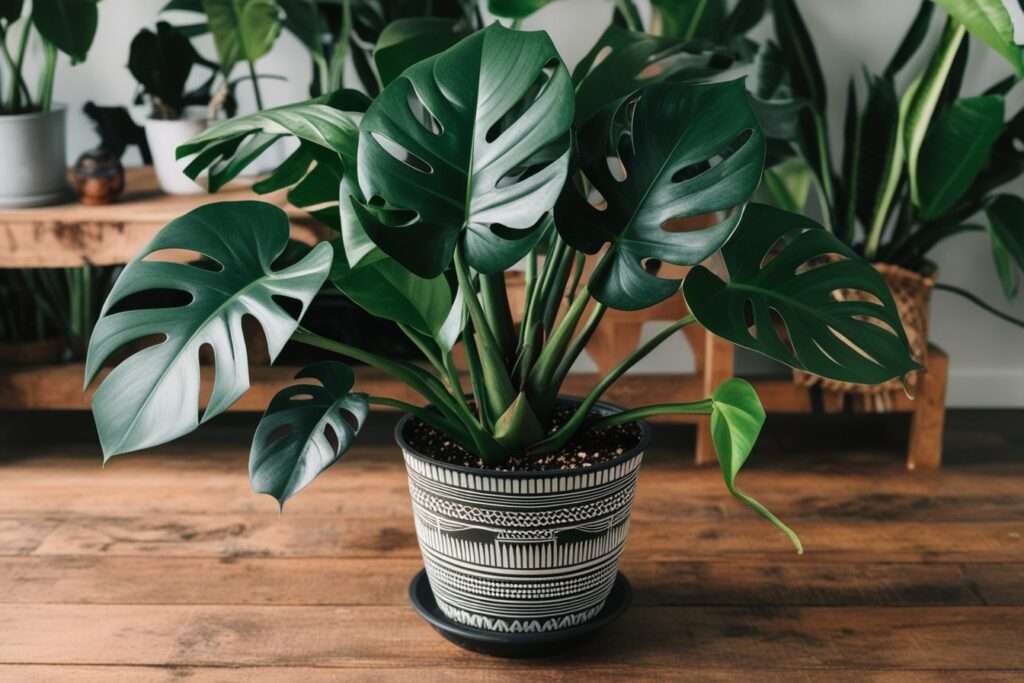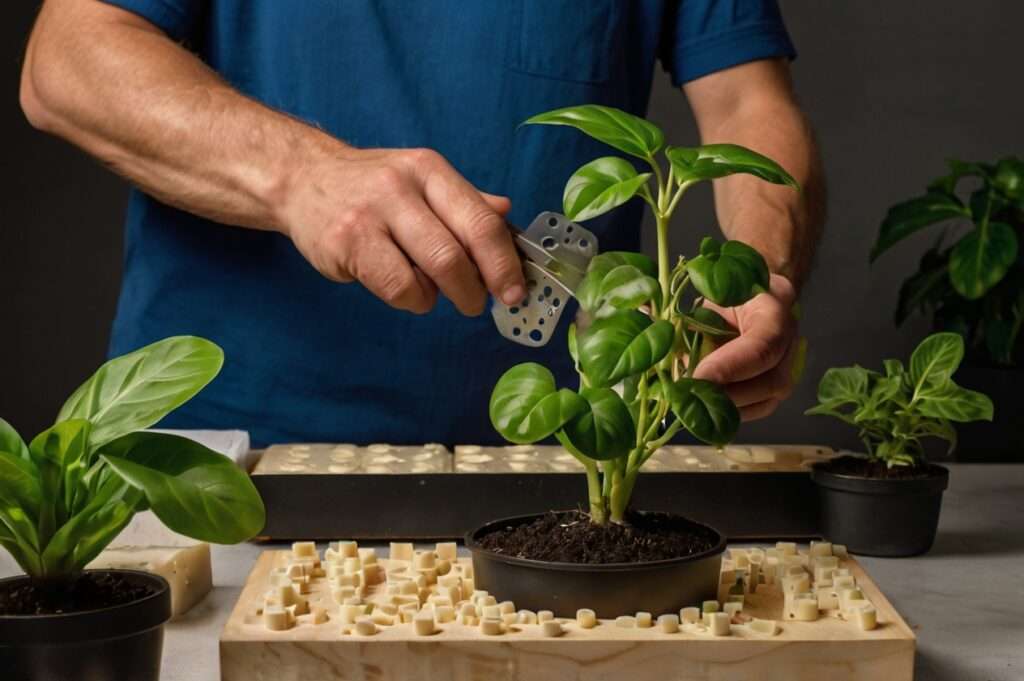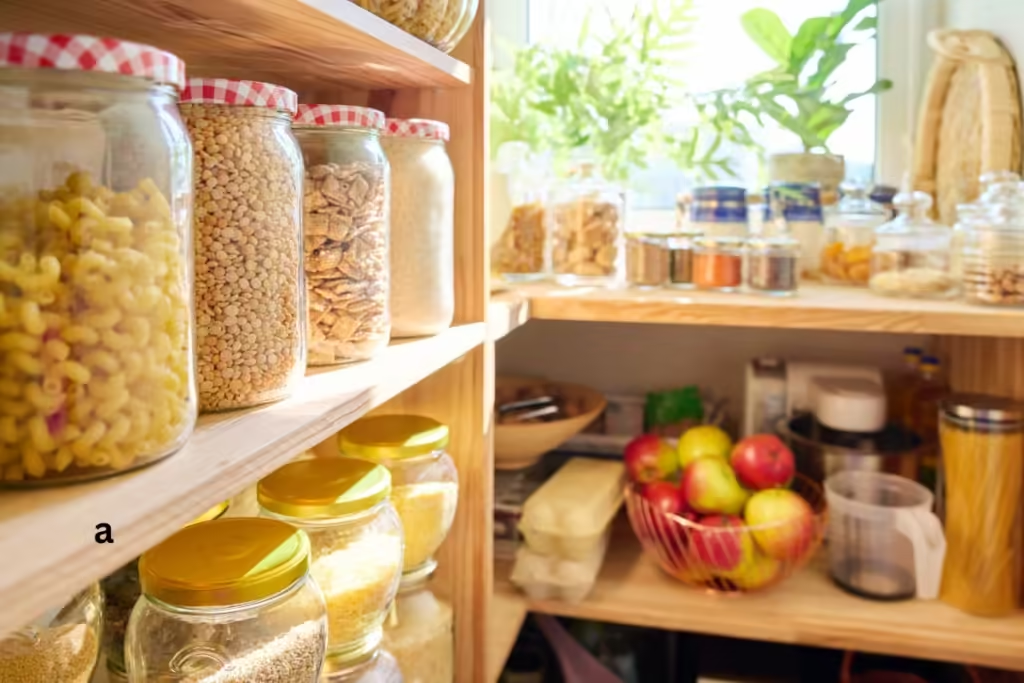
10 Amazing Swiss Cheese Plant Care Tips for Thriving Monstera Deliciosa
Love those iconic holey leaves? Swiss Cheese Plants are easier to care for than you might think! Give them bright, indirect light and a humid spot. Water when the soil feels dry, and don’t forget to feed them during growing season. With a little love, your Monstera will be the envy of plant parents everywhere!
Introduction
Welcome, plant enthusiasts! Today, we’re diving into the lush world of the Swiss Cheese Plant, a beloved houseplant that’s been stealing hearts and adorning homes for decades. Whether you’re a seasoned plant parent or just starting your green journey, this comprehensive guide will equip you with all the knowledge you need to help your Swiss Cheese Plant thrive. So, let’s embark on this verdant adventure together!
Understanding the Swiss Cheese Plant

Origin and History
The Swiss Cheese Plant, scientifically known as Monstera deliciosa, is a tropical wonder native to the rainforests of Central and South America. Despite its name, this plant isn’t from Switzerland at all! The “Swiss cheese” moniker comes from the distinctive holes that develop in its large, glossy leaves as the plant matures.
This fascinating plant has been a part of human culture for centuries. Indigenous peoples in its native regions have long used various parts of the plant for medicinal purposes and even consumption. The Monstera’s fruit, which resembles an elongated pinecone, is indeed edible when ripe and is said to taste like a blend of pineapple and banana.
In the mid-20th century, the Swiss Cheese Plant gained popularity as a houseplant, becoming a staple of interior design during the 1970s. Today, it’s experiencing a renaissance, beloved by millennials and plant enthusiasts worldwide for its dramatic foliage and relatively easy care requirements.
Characteristics and Unique Features
The Swiss Cheese Plant is a sight to behold. Its most striking feature is, of course, its large, heart-shaped leaves. These start out small and whole, but as the plant matures, they develop their characteristic splits and holes, known as fenestrations. This unique leaf structure is believed to be an adaptation that allows sunlight to reach the lower leaves in dense rainforest environments and helps the plant withstand strong winds.
In its natural habitat, the Monstera deliciosa can grow to impressive heights, sometimes reaching up to 70 feet tall! As a houseplant, however, it typically maxes out at about 6 to 8 feet. It’s a climber by nature, using aerial roots to attach itself to trees or other supports.
Another intriguing feature of the Swiss Cheese Plant is its ability to “sweat.” On humid days or after watering, you might notice water droplets forming on the leaf tips. This process, known as guttation, is perfectly normal and helps the plant regulate excess water.
Ideal Conditions for Growth

Optimal Lighting Requirements
When it comes to lighting, the Swiss Cheese Plant prefers bright, indirect light. In its natural habitat, it grows under the canopy of larger trees, receiving dappled sunlight. To replicate this at home, place your Monstera near a window with filtered light, perhaps through a sheer curtain.
While these plants can tolerate lower light conditions, they won’t thrive or develop their signature holes without adequate brightness. On the flip side, direct sunlight can scorch the leaves, so it’s crucial to find that sweet spot. A north or east-facing window often provides the perfect balance.
If you notice your plant’s leaves turning yellow or developing brown spots, it might be getting too much direct sun. Conversely, if the plant becomes leggy or the leaves remain small, it likely needs more light.
Temperature and Humidity Needs
As tropical plants, Monsteras thrive in warm, humid environments. They prefer temperatures between 65°F and 85°F (18°C to 29°C). They can tolerate brief periods outside this range but will suffer if exposed to temperatures below 50°F (10°C) for extended periods.
Humidity is another crucial factor for a happy Swiss Cheese Plant. They prefer humidity levels of 60% or higher, which can be challenging to maintain in many homes, especially during winter. To increase humidity, you can:
- Use a pebble tray filled with water beneath the pot
- Group your Monstera with other plants
- Place a humidifier nearby
- Mist the leaves regularly (although this only provides a temporary humidity boost)
If you notice brown, crispy edges on the leaves, it’s often a sign that the air is too dry for your plant’s liking.
Soil Preferences
The right soil mix is crucial for your Swiss Cheese Plant’s health. These plants prefer a well-draining, slightly acidic soil with a pH between 5.5 and 7. A good potting mix for Monsteras should:
- Retain some moisture without becoming waterlogged
- Allow for good aeration of the roots
- Provide essential nutrients
A suitable mix might consist of:
- 2 parts high-quality potting soil
- 1 part perlite or pumice (for drainage)
- 1 part coconut coir or peat moss (for water retention)
You can also add a handful of orchid bark to the mix to improve aeration and mimic the plant’s natural environment.
Watering and Feeding Your Plant
![]()
How Often to Water
Watering your Swiss Cheese Plant correctly is key to its health and growth. These plants prefer their soil to be consistently moist but not waterlogged. The frequency of watering will depend on various factors such as light, temperature, humidity, and the size of your plant.
As a general rule, water your Monstera when the top 2-3 inches of soil feel dry to the touch. This usually translates to watering once a week during the growing season (spring and summer) and less frequently during fall and winter.
When you do water, do so thoroughly until water runs out of the drainage holes at the bottom of the pot. This ensures that water reaches all parts of the root system and helps flush out any built-up salts from fertilizers.
Choosing the Right Fertilizer
To support healthy growth and those beautiful large leaves, your Swiss Cheese Plant will benefit from regular fertilization during its active growing season (spring and summer). A balanced, water-soluble fertilizer with an NPK ratio of 20-20-20 is ideal.
Feed your plant once a month during the growing season, diluting the fertilizer to half the recommended strength. It’s always better to under-fertilize than over-fertilize, as too much can lead to nutrient burn and damage the roots.
During fall and winter, when growth slows down, you can reduce fertilization to once every two months or stop altogether, depending on your plant’s growth rate.
Signs of Overwatering or Underwatering
Both overwatering and underwatering can stress your Swiss Cheese Plant, so it’s important to recognize the signs of each:
Overwatering signs:
- Yellowing leaves, especially lower ones
- Soft, mushy stems
- Brown, mushy spots on leaves
- Mold on the soil surface
- A persistently wet soil
Underwatering signs:
- Drooping or wilting leaves
- Crispy, brown leaf edges
- Slow growth
- Curling leaves
If you notice any of these signs, adjust your watering schedule accordingly. Remember, it’s easier to revive an underwatered plant than an overwatered one, so when in doubt, it’s better to wait an extra day before watering.
Related:
Repotting and Propagation

When and How to Repot
As your Swiss Cheese Plant grows, it will eventually outgrow its pot. Signs that it’s time to repot include:
- Roots growing out of the drainage holes
- The plant drying out quickly between waterings
- Slowed growth despite proper care
- The plant becoming top-heavy or unstable
Generally, you’ll need to repot every 2-3 years, preferably in spring when the plant is entering its active growing season. Choose a pot that’s 2-3 inches larger in diameter than the current one, ensuring it has adequate drainage holes.
To repot:
- Gently remove the plant from its current pot
- Loosen the root ball and remove any dead or rotting roots
- Place fresh potting mix in the new pot
- Position your plant in the new pot, ensuring it’s at the same depth as before
- Fill in around the roots with more potting mix
- Water thoroughly and place in a suitable location
Propagation Techniques
Propagating your Swiss Cheese Plant is a rewarding way to expand your plant family or share with friends. The easiest method is through stem cuttings:
- Choose a healthy stem with at least one node (the point where leaves emerge)
- Cut just below a node using clean, sharp scissors
- Remove any leaves from the lower part of the cutting
- Place the cutting in water or moist potting mix
- Keep in a warm, bright spot out of direct sunlight
- If in water, change it weekly; if in soil, keep it consistently moist
- Roots should develop in 2-4 weeks
- Once roots are a few inches long, you can pot up your new plant
Another method is air layering, which involves encouraging roots to grow on the plant before cutting:
- Choose a spot on the stem with a node
- Make a small incision in the stem
- Wrap the area with damp sphagnum moss and secure with plastic wrap
- When roots appear in the moss (usually after a few weeks), cut below the new roots and pot up your new plant
Common Pests and Issues

Identifying Pests and Diseases
While Swiss Cheese Plants are generally hardy, they can fall prey to certain pests and diseases. Common issues include:
- Spider mites: Tiny pests that cause stippling on leaves and fine webbing
- Mealybugs: Small, white, cottony insects that cluster on stems and leaf joints
- Scale insects: Small, flat, oval bugs that attach to stems and leaves
- Root rot: A fungal disease caused by overwatering, leading to soft, brown roots and yellowing leaves
- Leaf spot diseases: Various fungal or bacterial infections causing spots on leaves
Solutions and Preventative Measures
For pest infestations:
- Isolate the affected plant to prevent spread
- Wipe leaves with a solution of mild soap and water
- For severe cases, use neem oil or insecticidal soap
- Regularly inspect and clean your plants to catch issues early
For diseases:
- Improve air circulation around the plant
- Avoid getting water on the leaves when watering
- For root rot, remove the plant from soil, trim affected roots, and repot in fresh, well-draining soil
- For leaf spot diseases, remove affected leaves and treat with a fungicide if necessary
Preventative measures:
- Maintain proper watering and humidity levels
- Ensure good air circulation
- Clean leaves regularly to remove dust and check for pests
- Quarantine new plants before introducing them to your collection
Signs of Stress and How to Address Them
Your Swiss Cheese Plant may show signs of stress due to environmental factors or care issues. Here are some common signs and how to address them:
- Yellowing leaves: Often a sign of overwatering or nutrient deficiency. Check your watering routine and consider fertilizing.
- Brown leaf edges: Usually indicates low humidity or underwatering. Increase humidity and check your watering schedule.
- Leggy growth: Typically means the plant isn’t getting enough light. Move it to a brighter location.
- Leaves not developing holes: Young plants or those in low light may not develop fenestrations. Ensure adequate light and be patient.
- Drooping leaves: Could be due to underwatering, overwatering, or temperature stress. Check these factors and adjust as needed.
Remember, any changes should be made gradually to avoid further stressing your plant.
Conclusion
Congratulations! You’re now equipped with a wealth of knowledge about the magnificent Swiss Cheese Plant. From its fascinating history and unique characteristics to its care requirements and troubleshooting tips, you have all the tools you need to help your Monstera deliciosa thrive.
Remember, every plant is unique, and it may take some time to find the perfect balance for your specific Swiss Cheese Plant. Don’t be discouraged if you face some challenges along the way – it’s all part of the rewarding journey of plant parenthood.
As you watch your Monstera grow, developing those iconic splits and holes in its leaves, you’ll find it’s not just a plant, but a living piece of art that brings a touch of tropical paradise into your home. So go forth, nurture your Swiss Cheese Plant, and enjoy the lush, green beauty it brings to your space. Happy planting!
FAQs about Swiss Cheese Plant (Monstera deliciosa)
- What is a Swiss Cheese Plant?
- Answer: The Swiss Cheese Plant, or Monstera deliciosa, is a tropical houseplant known for its large, glossy leaves with unique holes and splits. It originates from the rainforests of Central and South America.
- How often should I water my Swiss Cheese Plant?
- Answer: Water your Swiss Cheese Plant when the top 2-3 inches of soil feel dry. This usually means watering about once a week during the growing season (spring and summer) and less frequently in fall and winter.
- What type of light does a Swiss Cheese Plant need?
- Answer: Monstera deliciosa thrives in bright, indirect light. It can tolerate lower light conditions but may not develop its characteristic holes. Avoid direct sunlight as it can scorch the leaves.
- What is the best soil for a Swiss Cheese Plant?
- Answer: Use a well-draining soil mix. A good mix might include 2 parts potting soil, 1 part perlite or pumice, and 1 part coconut coir or peat moss. This mix helps retain moisture while allowing excess water to drain.
- How do I increase humidity for my Swiss Cheese Plant?
- Answer: Increase humidity by using a pebble tray with water, grouping plants together, placing a humidifier nearby, or misting the leaves. The plant prefers humidity levels of 60% or higher.
- How can I propagate my Swiss Cheese Plant?
- Answer: Propagate through stem cuttings by cutting a healthy stem with at least one node and placing it in water or moist soil. You can also use air layering by wrapping a part of the stem with damp sphagnum moss until roots form.
- What are common pests that affect Swiss Cheese Plants?
- Answer: Common pests include spider mites, mealybugs, and scale insects. Regularly inspect your plant, and treat infestations with neem oil or insecticidal soap as needed.
- When should I repot my Swiss Cheese Plant?
- Answer: Repot your plant every 2-3 years or when you notice roots growing out of the drainage holes, the plant dries out quickly, or it becomes top-heavy. Choose a pot that’s 2-3 inches larger in diameter than the current one.
- What should I do if my Swiss Cheese Plant’s leaves are turning yellow?
- Answer: Yellowing leaves can indicate overwatering or a nutrient deficiency. Check your watering routine and consider fertilizing. Ensure the plant is not sitting in waterlogged soil.
- Why is my Swiss Cheese Plant not developing holes in its leaves?
- Answer: Young plants or those in low light may not develop their characteristic holes. Ensure your plant receives bright, indirect light and be patient, as fenestrations often develop as the plant matures.
References
- The Spruce
- Home Page: The Spruce
- Description: Provides a wide range of articles and tips on home and garden topics, including detailed plant care guides.
- Gardening Know How
- Home Page: Gardening Know How
- Description: Offers practical advice on plant care, gardening tips, and solutions to common plant problems.
- Royal Horticultural Society (RHS)
- Home Page: Royal Horticultural Society
- Description: A leading horticultural organization offering expert advice on plant care, gardening, and horticultural practices.
- Houseplant Central
- Home Page: Houseplant Central
- Description: A resource dedicated to houseplant care, providing guides on growing and maintaining indoor plants.
- University of Minnesota Extension
- Home Page: University of Minnesota Extension
- Description: Provides research-based information on various gardening and horticulture topics, including houseplant care.




